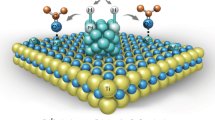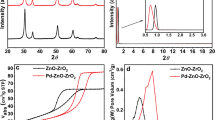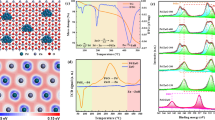Abstract
The hydrogenolysis of phenols to yield arenes is of importance to the production of fine chemicals, as well as biorefinery application; however, the conversion of phenols through cleavage of their strong C(sp2)–OH bonds remains a highly challenging task in synthetic chemistry. Here we report the use of Al(PO3)3-supported platinum nanoparticles for the selective hydrogenolysis of a broad range of phenols (including sterically highly demanding phenols and lignin model compounds) to afford arenes under relatively low temperatures (<150 °C) and ambient pressure (Ar/H2 = 9/1, 1 atm). This heterogeneous catalyst is expected to find a broad application in fine chemical synthesis and biorefinery.

This is a preview of subscription content, access via your institution
Access options
Access Nature and 54 other Nature Portfolio journals
Get Nature+, our best-value online-access subscription
$29.99 / 30 days
cancel any time
Subscribe to this journal
Receive 12 digital issues and online access to articles
$119.00 per year
only $9.92 per issue
Buy this article
- Purchase on Springer Link
- Instant access to full article PDF
Prices may be subject to local taxes which are calculated during checkout






Similar content being viewed by others
Data availability
The data supporting the findings of this study are available within this article and its Supplementary Information file or from the authors on reasonable request.
References
Bender, T. A., Dabrowski, J. A. & Gagné, M. R. Homogeneous catalysis for the production of low-volume, high-value chemicals from biomass. Nat. Rev. Chem. 2, 35–46 (2018).
Qiu, Z. & Li, C.-J. Transformations of less-activated phenols and phenol derivatives via C−O cleavage. Chem. Rev. 120, 10454–10515 (2020).
Gillet, S. et al. Lignin transformations for high value applications: towards targeted modifications using green chemistry. Green Chem. 19, 4200–4233 (2017).
Saidi, M. et al. Upgrading of lignin-derived bio-oils by catalytic hydrodeoxygenation. Energy Environ. Sci. 7, 103–129 (2014).
Jing, Y., Dong, L., Guo, Y., Liu, X. & Wang, Y. Chemicals from lignin: a review of the catalytic conversion involving hydrogen. ChemSusChem 13, 4181–4198 (2020).
Ohta, H. et al. Surface modification of a supported Pt catalyst using ionic liquids for selective hydrodeoxygenation of phenols into arenes under mild conditions. Chem. Eur. J. 25, 14762–14766 (2019).
Liu, W. et al. Ambient-pressure and low-temperature upgrading of lignin bio-oil to hydrocarbons using a hydrogen buffer catalytic system. Nat. Energy 5, 759–767 (2020).
Jongerius, A. L., Jastrzebski, R., Bruijnincx, P. C. A. & Weckhuysen, B. M. CoMo sulfide-catalysed hydrodeoxygenation of lignin model compounds: an extended reaction network for the conversion of monomeric and dimeric substrates. J. Catal. 285, 315–323 (2012).
Shao, Y. et al. Selective production of arenes via direct lignin upgrading over a niobium-based catalyst. Nat. Commun. 8, 16104–16112 (2017).
Huang, Y.-B., Yan, L., Chen, M.-Y., Guo, Q.-X. & Fu, Y. Selective hydrogenolysis of phenols and phenyl ethers to arenes through direct C–O cleavage over ruthenium–tungsten bifunctional catalysts. Green Chem. 17, 3010–3017 (2015).
Luo, Z. et al. Hydrothermally stable Ru/HZSM-5-catalysed selective hydrogenolysis of lignin-derived substituted phenols to bio-arenes in water. Green Chem. 18, 5845–5858 (2016).
Song, W. et al. Surface engineering of CoMoS nanosulfide for hydrodeoxygenation of lignin-derived phenols to arenes. ACS Catal. 9, 259–268 (2019).
Liu, G. et al. MoS2 monolayer catalyst doped with isolated Co atoms for the hydrodeoxygenation reaction. Nat. Chem. 9, 810–816 (2017).
Wu, K. et al. Engineering Co nanoparticles supported on defect MoS2–x for mild deoxygenation of lignin-derived phenols to arenes. ACS Energy Lett. 5, 1330–1336 (2020).
Zhang, J. et al. Surface engineering of earth-abundant Fe catalysts for selective hydrodeoxygenation of phenolics in liquid phase. Chem. Sci. 11, 5874–5880 (2020).
Kusumoto, S. & Nozaki, K. Direct and selective hydrogenolysis of arenols and aryl methyl ethers. Nat. Commun. 6, 6296–6302 (2015).
Zhang, Y.-F. & Shi, Z.-J. Upgrading cross-coupling reactions for biaryl syntheses. Acc. Chem. Res. 52, 161–169 (2019).
Cacchi, S., Ciattini, P. G., Morera, E. & Ortar, G. Palladium-catalysed triethylammonium formate reduction of aryl triflates. A selective method for the deoxygenation of phenols. Tetrahedron Lett. 27, 5541–5544 (1986).
Tobisu, M., Yamakawa, K., Shimasaki, T. & Chatani, N. Nickel-catalysed reductive cleavage of aryl−oxygen bonds in alkoxy- and pivaloxyarenes using hydrosilanes as a mild reducing agent. Chem. Commun. 47, 2946–2948 (2011).
Mesganaw, T., Fine Nathel, N. F. & Garg, N. K. Cine substitution of arenes using the aryl carbamate as a removable directing group. Org. Lett. 14, 2918–2921 (2012).
Alvarez-Bercedo, P. & Martin, R. Ni-catalysed reduction of inert C−O bonds: a new strategy for using aryl ethers as easily removable directing groups. J. Am. Chem. Soc. 132, 17352–17353 (2010).
Sergeev, A. G. & Hartwig, J. F. Selective nickel-catalysed hydrogenolysis of aryl ethers. Science 332, 439–443 (2011).
Shi, W.-J., Li, X.-L., Li, Z.-W. & Shi, Z.-J. Nickel catalysed reduction of arenols under mild conditions. Org. Chem. Front. 3, 375–379 (2016).
Ohgi, A. & Nakao, Y. Selective hydrogenolysis of arenols with hydrosilanes by nickel catalysis. Chem. Lett. 45, 45–47 (2016).
Xu, H. et al. Reductive cleavage of inert aryl C−O bonds to produce arenes. Chem. Commun. 51, 12212–12215 (2015).
Van der meer, H. The crystal structure of a monoclinic form of aluminum metaphosphate, Al(PO3)3. Acta Cryst. B 32, 2423–2426 (1976).
Cheng, H., Chen, L., Cooper, A. C., Sha, X. & Pez, G. P. Hydrogen spillover in the context of hydrogen storage using solid-state materials. Energy Environ. Sci. 1, 338–354 (2008).
Sheldon, R. A., Wallau, M., Arends, I. W. C. E. & Schuchardt, U. Heterogeneous catalysts for liquid-phase oxidations: philosophers’ stones or Trojan horses? Acc. Chem. Res. 31, 485–493 (1998).
Nelson, R. C. et al. Experimental and theoretical insights into the hydrogen-efficient direct hydrodeoxygenation mechanism of phenol over Ru/TiO2. ACS Catal. 5, 6509–6523 (2015).
Massoth, F. E. et al. Catalytic hydrodeoxygenation of methyl-substituted phenols: correlations of kinetic parameters with molecular properties. J. Phys. Chem. B 110, 14283–14291 (2006).
Yoon, Y., Rousseau, R., Weber, R. S., Mei, D. & Lercher, J. A. First-principles study of phenol hydrogenation on Pt and Ni catalysts in aqueous phase. J. Am. Chem. Soc. 136, 10287–10298 (2014).
Zhou, H., Wang, H., Sadow, A. D. & Slowing, I. I. Toward hydrogen economy: selective guaiacol hydrogenolysis under ambient hydrogen pressure. Appl. Cat. B 270, 118890 (2020).
Gafurov, M. R. et al. Quantitative analysis of Lewis acid centres of γ-alumina by using EPR of the adsorbed anthraquinone as a probe molecule: comparison with the pyridine, carbon monoxide IR, and TPD of ammonia. J. Phys. Chem. C 119, 27410–27415 (2015).
Nelson, N. C. et al. Phosphate modified ceria as a Brønsted acidic/redox multifunctional catalyst. J. Mater. Chem. A 5, 4455–4466 (2017).
Diallo-Garcia, S. et al. Identification of surface basic sites and acid−base pairs of hydroxyapatite. J. Phys. Chem. C 118, 12744–12757 (2014).
Ye, T.-N. et al. Stable single platinum atoms trapped in sub-nanometer cavities in 12CaO·7Al2O3 for chemoselective hydrogenation of nitroarenes. Nat. Commun. 11, 1020–1029 (2020).
Fenton, O. S. et al. Catalytic Lewis acid phosphorylation with pyrophosphates. Tetrahedron 68, 9023–9028 (2012).
Gajewski, E., Steckler, D. K. & Goldberg, R. N. Thermodynamics of the hydrolysis of adenosine 5′-triphosphate to adenosine 5′-diphosphate. J. Biol. Chem. 261, 12733–12737 (1986).
Rotole, J. A. & Sherwood, P. M. A. Aluminum metaphosphate (Al(PO3)3) by XPS. Surf. Sci. Spectra 5, 67–74 (1998).
Chan, G. H., Ong, D. Y., Yen, Z. & Chiba, S. Reduction of N,N-dimethylcarboxamides to aldehydes by sodium hydride–iodide composite. Helv. Chim. Acta. 101, e1800049 (2018).
Gong, D. et al. Syndiotactically enriched 1,2-selective polymerisation of 1,3-butadiene initiated by iron catalysts based on a new class of donors. Polymer 50, 5980–5986 (2009).
Acknowledgements
This work was supported by JSPS KAKENHI JP18H05259, JP19K15357, JP20H04803 and JP17H06443. We are grateful to N. Chatani (Osaka University) for helpful discussions. We would like to thank K. Yamaguchi (U. Tokyo) for generous sharing of analytical instruments. A part of this work was conducted at the Advanced Characterisation Nanotechnology Platform of the University of Tokyo, supported by the Nanotechnology Platform of the Ministry of Education, Culture, Sports, Science and Technology (MEXT), Japan.
Author information
Authors and Affiliations
Contributions
X.J. and K.N. designed the studies and conceived the main idea. R.T. and X.J. executed all of the experimental work except for the FTIR measurements using the probe molecules. T.A., H.M. and T.S. carried out the FTIR experiments using pyridine or p-cresol as the probe molecule. All authors discussed the results and wrote the paper.
Corresponding authors
Ethics declarations
Competing interests
The authors declare no competing interests.
Additional information
Peer review information Nature Catalysis thanks Changhai Liang, Igor Slowing and the other, anonymous, reviewer(s) for their contribution to the peer review of this work.
Publisher’s note Springer Nature remains neutral with regard to jurisdictional claims in published maps and institutional affiliations.
Supplementary information
Supplementary Information
Supplementary Methods, Tables 1 and 2, Figs. 1–15, GC chromatograms, GC–MS or NMR spectra of the crude reaction mixtures and references.
Rights and permissions
About this article
Cite this article
Jin, X., Tsukimura, R., Aihara, T. et al. Metal–support cooperation in Al(PO3)3-supported platinum nanoparticles for the selective hydrogenolysis of phenols to arenes. Nat Catal 4, 312–321 (2021). https://doi.org/10.1038/s41929-021-00598-x
Received:
Accepted:
Published:
Issue Date:
DOI: https://doi.org/10.1038/s41929-021-00598-x



